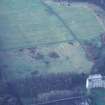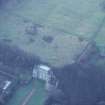Aerial Photographic Interpretation
Date February 1998
Event ID 572752
Category Recording
Type Aerial Photographic Interpretation
Permalink http://canmore.org.uk/event/572752
NS98SE RRX505 986 807
NS 981 804 A programme of geophysical survey and trial excavations took place on the line of the Antonine Wall as part of Historic Scotland's review of the Scheduling of this monument. To the W of the Gil Burn aerial photographs show two distinct broad linear features, both consistent in appearance with the Antonine Wall ditch (see PSAS 126, 364, illus 15). The first runs E-W, and has been previously confirmed as an alignment of the Roman frontier; a second ditched feature appears to diverge from the E-W line and runs S to cross the Gil Burn further upstream. This latter has been considered as a possible second frontier feature alignment. The present work was designed to establish whether two frontier arrangements existed here and, if so, to examine the relationship between them. The grounds at Kinneil were also the site of a medieval village which was cleared in the 17th century by the owners of Kinneil House to create parkland.
The geophysical survey located two linear anomalies corresponding to those identified on the aerial photographs, as well as the remains of one definite rectilinear structure and a second possible structure.
Four trenches were excavated, located with reference to the aerial photographs and the results of the geophysical survey. The excavations revealed the Antonine Wall on its E-W alignment, confirming previous observations. The ditched feature diverging from this line to the SE was found to be a cobbled path set in a hollow; it is probably a path, and was presumably part of the 17th-century landscaping.
The remains of a beam slot, a paved area, a well, and stone walls were discovered at various points in the trenches, and relate to the former Kinneil village. Artefacts recovered during the excavations comprise pottery, glass, clay pipe and a silver long cross penny dating to Alexander III 2nd coinage c 1280-86.
A report has been lodged with the NMRS.
Sponsor: Historic Scotland
B Glendinning 1998; L J F Keppie 1999













